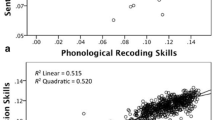Abstract
Children who are backward in reading are strikingly insensitive to rhyme and alliteration1. They are at a disadvantage when categorizing words on the basis of common sounds even in comparison with younger children who read no better than they do. Categorizing words in this way involves attending to their constituent sounds, and so does learning to use the alphabet in reading and spelling. Thus the experiences which a child has with rhyme before he goes to school might have a considerable effect on his success later on in learning to read and to write. We now report the results of a large scale project which support this hypothesis.
Similar content being viewed by others
References
Bradley, L. & Bryant, P. E. Nature 271, 746–747 (1978).
Bradley, L. Assessing Reading Difficulties (Macmillan, London, 1980).
Goldstein, D. M. J. educ. Psychol. 68, 680–688 (1976).
Liberman, I. et al. in Toward a Psychology of Reading (eds Reber, A. & Scarborough, D.) (L. Erlbaum Association, Hillsdale, New Jersey, 1977).
Lunderg, I., Olofsson, A. & Wall, S. Scand. J. Psychol. 21, 159–173 (1980).
Author information
Authors and Affiliations
Rights and permissions
About this article
Cite this article
Bradley, L., Bryant, P. Categorizing sounds and learning to read—a causal connection. Nature 301, 419–421 (1983). https://doi.org/10.1038/301419a0
Received:
Accepted:
Issue Date:
DOI: https://doi.org/10.1038/301419a0
- Springer Nature Limited
This article is cited by
-
Towards a dynamic, comprehensive conceptualization of dyslexia
Annals of Dyslexia (2024)
-
Longitudinal development of category representations in ventral temporal cortex predicts word and face recognition
Nature Communications (2023)
-
Empowering first graders with computer-based training to master pre-reading skills and bridge the learning gap
Education and Information Technologies (2023)
-
The different linguistic profiles in Arabic speaking kindergarteners and relation to emergent literacy
Reading and Writing (2023)
-
The effects of second language literacy instruction on first language literacy: a comparison between Hindi–English and Urdu–English Canadian bilinguals
Journal of Cultural Cognitive Science (2022)





